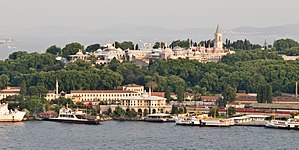Count of the East
| Count of the East | |
|---|---|
| File:Seal of the Count of the East.svg Seal of the Count of the East | |
| Style | Count (informal) The Glorious (formal) His Excellency (international) |
| Member of | |
| Residence | Heraion |
| Appointer | The Monarch |
| Term length | At the Emperor's pleasure |
| Inaugural holder | Boniface Anicius (restoration) |
| Formation | 2 June 1833 (restoration) |
The Count of the East (Latin: Comes Orientis) is the appointed governor of the Diocese of the East, also known as Perateia. The Count is the imperial viceroy and head of the sub-national government in Perateia. As an appointed office, the Count of the East is not responsible to the elected Perateian Assembly, but instead the Emperor and central imperial government.
The office of Count was originally established in the eastern Periclean region in the 3rd century CE, maintaining the role of governor over the modern day territories of Alanahr, Kocispara, Vardana, and northern Fahran. Following the loss, and later abandonment, of the eastern provinces in the 6th century, the last late classical count, Aurelius Tigran, established himself as King over parts of the former Latin holdings centered on Leonopolis, where successive kings continued to claim the title of Count of the East. Use of the office remained dormant in Latium until 1833, and the Lihnidosi Rebellion, which resulted in Latin control over parts of Vardana, namely Leonopolis and the surrounding countryside. Since the office was reactivated in 1833, 34 individuals have served, including with 5 future emperors.
Today, the Count of the East is the chief magistrate of the Diocese of the East and serves as the head of government of Perateia and leader of the Perateian Executive Council. The count is ex offico the Augustal Prefect of Perateia, and a member of the Perateian Assembly.
Role
The Count of the East is the appointed governor of the Diocese of the East and the only such governor to hold the title of Count, in lieu of the traditional vicar; however, the Count is also Augustal Prefect of Perateia, a caesarean province that is coterminous with the Eastern Diocese. As governor, the count is charged with the primarily executive duties in the diocese. These functions include enacting legislation passed by the diocesan assembly, or in some instances issue diocesan edicts. Through these edicts, the count can declare public emergencies within the diocese, temporarily suspend or alter local law, ordinances, etc.
A unique power held by the count is to grant clemency or issues pardons to individuals that are sentenced under customary Vardanan law; however, this practice rarely takes place. While this clemency power exists, any act of clemency must be countersigned by the emperor. The count is also afforded a role on the Board of Trade, which oversees toll schedules on passage through the Alcaean Straits.
The count also holds veto authority over legislation passed by the Perateian Assembly. There is no mechanism for the Assembly to overturn a veto other than direct Imperial Petition. The count is also responsible for submitting a budget to the Treasury Board and the Assembly. In addition, the count has the power of appointment to appoint local mayors and other local officials. More recently, the Count has convened a Perateian equivalent to the imperial Local Council. This action has seen mixed support, as the Assembly asserts that it is a move to circumvent any legislative process. However, it has seen widespread support from communities and local officials throughout the Eastern Diocese.
In addition, the Count is the leader of the Perateian Auxiliary Forces, which provide for general policing and internal security, along with support for traditional legions in defense of the diocese, in event of war or civil unrest. Due to this role as leader of the Auxiliary, many counts come from military backgrounds and, until recently, lacked local ties.
Executive Council
One of the Counts primary roles is as the diocesan head of government, which it maintains by virtue of its role as the presiding officer of the Executive Council. Through the Council, the Count leads and directs the diocesan government and formulates policy. Key members are appointed by the emperor, often on the advice and recommendation of the Count of the East, with all secondary officers appointed by the Count. The Count has the power to dismiss members of the Executive Council. Along with providing the council with leadership, the count is the chief magistrate of the Military Bureau and acts as the nominal commander in chief of the Perateian Auxiliary Forces.
Perateian Assembly
The Count also holds a seat on the Perateian Assembly, and remains one of the few remaining appointed seats on the Assembly. In practice, the Count is the first man of the assembly, a role which he holds in the emperor's physical absence. This role allows the Count to convene and adjourn the assembly, as well as dissolve the assembly for new elections, or even suspend the legislative process in extreme circumstances. The Count also plays a major role in establishing the legislative agenda, and holds many privileges of a presiding officer. The only time that a count was not first man of the assembly was during the junior reign of Emperor Jason VI, who directly ruled from the Eastern Diocese and controlled its government.
Amenities and privileges

As viceroy, the count is granted many amenities that are traditionally reserved for the emperor. Chief of these is Heraion, which is the primary residence and office of the count of the east. Prior to 1833, Heraion, served as the official residence of the King of Vardana, and has since served as the chief imperial residence in Perateia. Eudoikoi, located approximately 2 miles from Heraion, serves as the count's official guest house and secondary residence for the count if needed, most often in the event the emperor or a member of the imperial family visits Leonopolis. Tigrandas is the official county residence of the count, and is located in the province of Simara.
It is widely known that the count is provided an allowance of at least $50,000 per year to cover expenses incurred while in office. However, the most recent release of annual compensation for the count is less widely known, and as of 1983, the annual compensation was reportedly $75,000.
Precedence and form of address
The count of the east is often considered among the most prestigious counts and political offices in Latium. Holding the office affords an individual the rank of Second Class Count, and the style of "The Glorious" (vir gloriosus/gloriosissimus). An individual holds this distinction for life, even after leaving office.
List of Counts of the East
| Portrait | Name (Birth–Death) |
Term of office | Tenure | Other offices previously held |
Monarch (Reign) | |
|---|---|---|---|---|---|---|

|
The Glorious Boniface Anicius CI EAA (1797–1859) |
2 June 1833 |
1 January 1841 |
7 years, 213 days |
|
Andreas II Gentilius File:Seal of Latin Emperor Andreas II.svg (1810–1836) |
| Michael IV Gentilius File:Seal of Latin Emperor Michael IV.svg (1836–1842) | ||||||

|
His Imperial Highness Theophylactus, Prince of Youth CI EE EAA ECA MCG MCC (1819–1891) |
1 January 1841 |
15 November 1846 |
5 years, 318 days |
| |
| Andreas III Anicius File:Seal of Latin Emperor Andreas III.svg (1842–1846) | ||||||

|
The Glorious Syagrius Licinius CI MCG (1800–1868) |
15 November 1846 |
11 February 1850 |
3 years, 81 days |
|
Theophylactus I Anicius File:Seal of Latin Emperor Theophylactus I.svg (1846–1891) |

|
The Glorious Theodosius Ostia CI (1799–1852) |
15 July 1850 |
17 December 1852 |
2 years, 155 days |
| |

|
The Glorious Constantine Judocus CI (1780–1863) |
17 May 1853 |
11 June 1859 |
6 years, 25 days |
| |

|
The Glorious Valens Lentulus CI (1806–1898) |
11 June 1859 |
7 July 1865 |
6 years, 26 days |
| |

|
The Glorious Thomas Dorsuo CI (1801–1876) |
7 July 1865 |
26 June 1866 |
354 days |
| |

|
The Glorious Duke Flavius Julius CI (1812–1888) |
26 June 1866 |
29 February 1868 |
1 year, 248 days |
| |

|
The Glorious Marius Aemelius, Duke of Narona CI (1812–1899) |
1 December 1868 |
15 October 1872 |
3 years, 319 days |
| |

|
The Glorious Andreas Otacilius CI (1827–1880) |
15 October 1872 |
17 February 1874 |
1 year, 125 days |
| |

|
The Glorious Duke Leo Pola CI (1825–1900) |
17 February 1874 |
4 April 1880 |
6 years, 47 days |
| |

|
His Imperial Highness John, Prince of Youth CI EE EAA ECA MCG MCC (1845–1925) |
4 April 1880 |
22 May 1890 |
10 years, 48 days |
| |

|
The Glorious Theophylactus Aemelius CI EAA MCC (1838–1900) |
9 January 1892 |
21 June 1895 |
3 years, 163 days |
|
John XIII Anicius File:Seal of Latin Emperor John XIII.svg (1891–1918) |

|
His Imperial Highness Michael, Duke of Ravenna CI EE MCG (1856–1911) |
21 June 1895 |
6 May 1902 |
6 years, 319 days |
| |
| File:Aimone di Savoia Duca di Spoleto.jpg | His Imperial Highness Marius, Prince of Youth CI EE EAA ECA MCG MCC MLO (1878–1928) |
6 May 1902 |
2 March 1908 |
5 years, 301 days |
| |
| Office vacant direct rule from 1908 to 19201 | ||||||
| Marius IV Anicius File:Seal of Latin Emperor Marius IV.svg (1918–1928)2 | ||||||

|
The Glorious Aram Zakarian CI MCC (1854–1924) |
19 October 1920 |
22 January 1924 |
3 years, 95 days |
| |

|
The Glorious John Anicius, Duke of Beroea CI EE EAA MCG ECC (1880–1964) |
6 November 1924 |
14 April 1928 |
3 years, 160 days |
| |
| Joanna I Anicia File:Seal of Latin Empress Joanna I.svg (1928–1934) | ||||||

|
The Glorious Elias Apion CI (1877–1957) |
14 April 1928 |
7 June 1935 |
7 years, 54 days |
| |
| Constantine XIX Anicius File:Seal of Latin Emperor Constantine XIX.svg (1934–1945) | ||||||

|
The Glorious Isaac Vachutian CI (1889–1964) |
7 June 1935 |
20 March 1940 |
4 years, 287 days |
| |

|
The Glorious Avienus Tarquinius CI (1900–1969) |
20 March 1940 |
6 June 1942 |
2 years, 78 days |
| |

|
His Imperial Majesty John, Father of the Emperor CI EE EAA MCG ECC (1880–1964) |
6 June 1942 |
1 January 1949 |
6 years, 209 days |
| |
| Diana I Anicia File:Seal of Latin Empress Diana Augusta.svg (1945–2000) | ||||||

|
The Glorious Andranik Lernakan CI ECA MCC (1889–1949) |
1 January 1949 |
6 August 1949 |
217 days | ||

|
The Glorious Duke Michael Claudius CI EE EAA ECA MCC MCG (1903–2005) |
2 February 1950 |
18 October 1954 |
4 years, 258 days | ||

|
The Glorious Prince Zenobios Malenios CI MCG (1910–1988) |
18 October 1954 |
13 July 1964 |
9 years, 269 days | ||
| His Royal Highness Peter, Duke of Keld CI EE EAA MCG MCC (1930–1996) |
13 July 1962 |
19 June 1970 |
5 years, 341 days | |||

|
The Glorious Constantine Turullius CI MCC MOP (1910–1993) |
19 June 1970 |
31 March 1973 |
2 years, 285 days | ||

|
The Glorious Josephus Verrucosus CI EE EAA (1928–) |
31 March 1973 |
2 September 1976 |
3 years, 155 days | ||

|
The Illustrious Duke Michael Claudius CI EE EAA ECA MCC MCG (1903–2005) |
17 September 1976 |
1 January 1990 |
13 years, 106 days | ||

|
His Imperial Highness Jason, Prince of Youth CI EE EAA ECA MCG MCC MLO (1964–2016) |
1 January 1990 |
2 February 1993 |
3 years, 32 days | ||
| Office vacant direct rule from 1993 to 20013 | ||||||
| Jason VI Claudius File:Seal of Latin Emperor Jason VI.svg (2000–2016)4 | ||||||

|
The Glorious Constantine Orontes CI CC (1934–2020) |
7 May 2001 |
9 May 2005 |
4 years, 2 days | ||

|
The Glorious Andronicus Syrgiannes CI IA (1962–) |
17 December 2005 |
8 October 2011 |
5 years, 295 days | ||

|
The Glorious Aurelius Stilicho CI ECA MCC MOP (1940–) |
8 October 2011 |
28 February 2015 |
3 years, 143 days | ||
| Office vacant direct rule from 2015 to 20175 | ||||||
| Constantine XX Claudius  (2016–)6 | ||||||

|
The Glorious Andreas Pinarius CI MCG (1965–) |
9 February 2017 |
Incumbent | 7 years, 293 days | ||
- Notes
- 1 Direct rule was installed and the office of Count of the East was officially vacant during the junior emperorship of Marius IV, who governed from his court in Leonopolis, from 2 March 1908 to 19 October 1920.
- 2 Junior emperor from 1908 to 1918.
- 3 Direct rule was installed and the office of Count of the East was officially vacant during the junior emperorship of Jason VI, who governed from his court in Leonopolis, from 2 February 1993 to 7 May 2001.
- 4 Junior emperor from 1993 to 1999.
- 5 Direct rule was installed and the office of Count of the East was officially vacant during the junior emperorship of Constantine XX, who governed from his court in Leonopolis, from 28 February 2015 to 1 January 2017.
- 6 Junior emperor from 2015 to 2016.
List of former living counts
As of 2021 there are four living former Counts of the East:
Duke Joseph Verrucosus
(1973–1976)
Age 96Andronicus Syrgiannes
(2005–2011)
Age 62Aurelius Stilicho
(2011–2015)
Age 84



